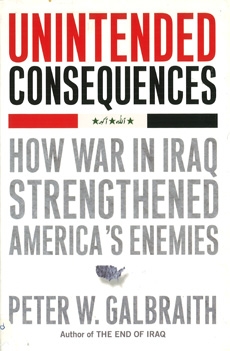|
INTRODUCTION
George W. Bush launched and lost America’s Iraq War. Losing is just one way in which the Iraq War did not turn out as planned.
- A war intended to eliminate the threat from Saddam Hussein’s nonexistent weapons of mass destruction ended up with Iran and North Korea much closer to having deployable nuclear weapons.
- A war intended to fight terror has helped the terrorists.
- A war intended to bring freedom and democracy to Iraq now has U.S. troops fighting for pro-Iranian Shiite theocrats and alongside unreformed Baathists.
- A war intended to undermine Iran’s ayatollahs has resulted in a historic victory for Iran. Iranian-backed political parties control Iraq’s government and armed forces, giving Iran a role in Iraq that it has not had in four centuries.
- A war intended to promoted democracy in the Middle East has set it back.
- A war intended to intimidate Syria and make Israel more secure has left Israel more threatened and Syria less isolated.
- A war intended to enhance America’s relations with moderate Islam has made Turkey among the most anti-American countries in the world.
- A war intended to showcase American power has highlighted the deficiencies of U.S. intelligence, the incompetence of American administration, and the limitations on the American military.
- A war intended to boost American global leadership has driven U.S. prestige to an all-time low.
- A war intended to consolidate Republican power in Washington for a generation cost the GOP control of both houses of Congress in 2006, and seems likely to help elect an antiwar Democrat president in 2008.
- A war intended to make America more secure has left the country weaker.
- “The United States of America will not permit the worlds most dangerous regimes to threaten us with the worlds most destructive weapons,” President Bush told Congress in his first State of the Union speech, on January 29, 2002. America, he promised, will “deny terrorists and their state sponsors the materials, technology, and expertise to make and deliver weapons of mass destruction.” And he warned, “America will do what is necessary to ensure our nation’s security.”
George W. Bush’s performance never matched his rhetoric. A year after that speech, he launched a war to eliminate Iraqi weapons of mass destruction that did not exist. Meanwhile, North Korea—a country he said was in an “Axis of Evil” with Iraq and Iran—took advantage of Bush’s preoccupation with a phantom Iraqi threat and withdrew from the Nuclear Non-Proliferation Treaty. North Korea went on to make eight nuclear weapons from plutonium that had previously been safeguarded by the International Atomic Energy Agency (IAEA) and then tested one in 2006. President Bush did nothing about North Korea for years before eventually concluding an agreement that required North Korea to dismantle its aging reactor but effectively allowed it to keep its nukes.
.....
Iraq’s Ethnic and Sectarian Divisions
Kurdistan: Situated in Iraq’s northeast, the Kurdistan Region is a de facto independent state with its own president, parliament, flag, and army. Kurdistan’s present boundaries follow the Green Line (shown as a dotted line on the map) that separated the Kurdish enclave established in 1991 from territory controlled by Saddam’s army.
The Disputed Areas: Kirkuk and its surrounding governorate are at the heart of an eighty-year territorial dispute between Kurds and Arabs. The Kurds, who have controlled Kirkuk since helping liberate the province in 2003, want a referendum, as required by Iraq’s Constitution, to determine whether Kirkuk is incorporated into Kurdistan. Kirkuk’s Arabs and Turkmen oppose the referendum, which was postponed front its constitutionally required December 31, 2007, deadline. Kurds also claim a swath of territories south and west of the Green Line all the way from the Syrian border to the Iranian border. Arab Iraqis accept Kurdistan’s annexation of much purely Kurdish inhabited territory but reject other of Kurdistan's claims.
The Sunni Center: Iraq’s Sunni majority areas in Iraq’s center and west form a rough triangle beginning at the tri-junction of Iraq, Jordan, and Saudi Arabia, going east to Baghdad’s western suburbs and then heading northwest to Mosul and back southwest along the Syrian and Jordanian borders. The Sunni Center comprises: Anbar Governorate, which is 98 percent Sunni and includes the vast western desert bordering Saudi Arabia and Jordan and the one-time insurgent hotbeds of Fallujah and Ar Rarnadi; Salahaddin Governorate, which includes Saddam Hussein’s home region of Tikrit and Samarra, where the destruction of the Shiite Askariya shrine in February 2006 triggered a dramatic escalation of Iraq’s Sunni-Shiite civil war; and most of Nineveh Governorate, with Mosul as its capital. Mosul, Iraq’s third largest city, is divided by the Tigris River between a Sunni west and a Kurdish east. To Mosul’s east are Christian villages that would like to form a majority Christian Nineveh Plain Autonomous Region; to the north, west, and east are Yazidi villages and towns; and to the west is volatile Tel Afar with its large Turkmen population.
The Shiite South: The southern half of Iraq is Shiite. This area is demarcated by a line starting on the Euphrates north of Karbala and extending east to the southern reaches of Baghdad and then on to the Iranian border. It includes the holy cities of Karbala and Najaf as well as Basra, Iraq’s second city, and access to the Persian Gulf. Iraq’s Council of Representatives has enacted a law permitting Iraq’s nine southern Governorates to form a single Shiite Region with the same powers as Kurdistan.
Baghdad: Baghdad, with 20 percent of Iraq’s population, is divided between a mostly Shiite east and a mostly Sunni west. After 2003, its once mixed neighborhoods became either Shiite, or Sunni.
| 